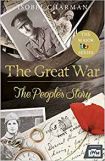The Great War: The People's Story by Isobel Charman
| The Great War: The People's Story by Isobel Charman | |
|
| |
| Category: History | |
| Reviewer: John Van der Kiste | |
| Summary: The prelude to, course and aftermath of the Great War in Britain, seen through the (mainly unpublished) letters, memoirs and diaries of a few individuals at home and at the front. | |
| Buy? Yes | Borrow? Yes |
| Pages: 515 | Date: July 2014 |
| Publisher: Random House | |
| ISBN: 9781847947253 | |
|
| |
During this centenary year, we have seen many ways of telling the history of the conflict which broke out among the Great Powers of Europe and soon involved all four corners of the world. This volume, based on a recent ITV series of the same title, approaches it from an angle which I have not seen before. It follows the course of events over the four years through the letters, memoirs and diaries of about a dozen individuals as it presents their story against the background of fighting on the continental mainland, and of bereavement, shortages and more at home.
Divided into five sections, it opens with an overview of what would be seen in hindsight as the last months of ‘the old order’. 1914 began, like many a year before and since, with gales and floods, to be followed by a glorious sunny summer. Yet for the young and middle-aged adults to whom we are introduced in the first few pages, events at home and abroad were ominous. For former Cambridge student turned aspiring ‘cotton king’ Alan Lloyd and his girlfriend Dorothy Hewetson, carpenter Reg Evans, suffrage group organiser Kate Parrye Frye and her actor boyfriend John Collins, writer and vegetarian pioneer Hallie (Harriet) Miles and her husband Eustace, and the vicar of Great Leighs in Essex, Andrew Clark, whatever the blissful state of their personal lives, there was little cheer ahead. As far as the political establishment was concerned, two crises were competing for attention – the passing of the controversial Home Rule for Ireland Bill, and Austro-Serbian tension following the murder of the Austrian heir Archduke Franz Ferdinand and his wife at Sarajevo. Like many others, Kate noted in her diary that, in the light of ‘such European complications’, parliamentary quarrels at Westminster would probably have to take a second place. By the first week of August, such forebodings had become reality.
It is through the eyes of these individuals, and though a few more who are introduced to us at later stages, that we see how the war gathered pace, and how it affected people at home as well as those who went to fight on the western front. Many of them were destined never to return home, and if they did, they were physically or mentally scarred for life. Those who joined the army and went abroad in a cheerful gung-ho frame of mind soon found their mood tempered fiercely by the reality of trench warfare and the likelihood of death or, even worse, dying by inches from their wounds. As one of them wrote to his family at home, ‘I hate flag wagging and Union Jack hurrahing.’ The optimism of those who believed that the struggle would be over by Christmas was rapidly dispelled. Within a few weeks, British civilians had got the message that this war would involve them all in a way never seen before. Foodstuffs were in short supply, drastic restrictions on lighting, including the use of torches and striking matches, were imposed on all, and there was every possibility that Zeppelins would invade England. Bombs reached the east coast at an early stage with the attacks on Scarborough and Hartlepool, leaving several hundred killed or injured.
As the war dragged on, with news (albeit heavily censored, in order not to depress civilian morale) of escalating casualties at Ypres, the Somme, Amiens and other long-drawn-out battles in Europe, compulsory conscription was introduced, and women went to work in the factories. Their menfolk wrote of increasingly harrowing conditions at the front, and in some cases these letters turned out to be the last thing they would ever write. First-time fathers would learn with joy of children being born, but would not be spared to return home and see them. Even though the United States of America entered the war on behalf of the allies in 1917, the outcome remained uncertain for many more months, and by spring the following year civilian morale was beginning to crack. In the words of one diarist, sickened by such tragedies as children killed by bombs falling on their school in east London, it was often a relief to return to work, which seemed ‘the only way not to dwell on these horrors’. It was noticed that Londoners suddenly stopped smiling, and instead went about their business in ‘a grim, hard and quiet manner’.
In June 1918, soon after the Kaiser had declared a national holiday to celebrate the imminent triumph of his army (never count your chickens, Your Imperial Majesty), many in Britain, government minister and civilian alike, feared that the Germans were on the brink of victory. I found this section the most dramatic in the whole book, reading how the situation slowly changed in the final months from near-despair to success, if that is the right word. For with the appalling cost in human flesh and blood, to say nothing of what would later be seen as a shattered economic position, the end of the war and the onset of peace could hardly be called a victory. An epilogue ties up loose ends by telling us what became of those whose letters and diaries are quoted throughout.
A bare list of assassinations, declarations, battles, and treaties may chart the essentials, but little more. Like the exhibition on the Great War which I saw at the Imperial War Museum in London a few days before I received this book, the voices, or rather the writings, of those who experienced the miseries of those four years, bring it all home in much sharper focus. This is a deeply sobering, essential read.
We can also recommend:
Great Britain's Great War by Jeremy Paxman
A Broken World: Letters, diaries and memories of the Great War by Sebastian Faulks and Hope Wolf
Please share on: ![]() Facebook,
Facebook, ![]() Twitter and
Twitter and
![]() Instagram
Instagram
![]() You can read more book reviews or buy The Great War: The People's Story by Isobel Charman at Amazon.co.uk Amazon currently charges £2.99 for standard delivery for orders under £20, over which delivery is free.
You can read more book reviews or buy The Great War: The People's Story by Isobel Charman at Amazon.co.uk Amazon currently charges £2.99 for standard delivery for orders under £20, over which delivery is free.
![]() You can read more book reviews or buy The Great War: The People's Story by Isobel Charman at Amazon.com.
You can read more book reviews or buy The Great War: The People's Story by Isobel Charman at Amazon.com.
 The Great War: The People's Story by Isobel Charman is in the Top Ten History Books of 2014.
The Great War: The People's Story by Isobel Charman is in the Top Ten History Books of 2014.
Comments
Like to comment on this review?
Just send us an email and we'll put the best up on the site.


